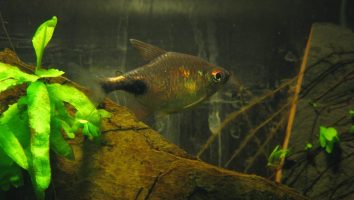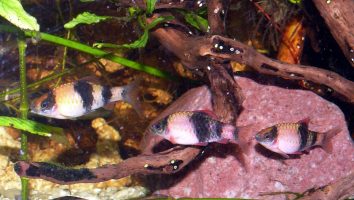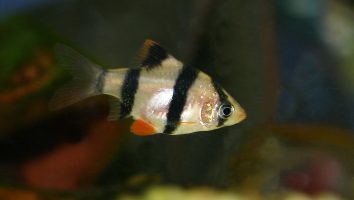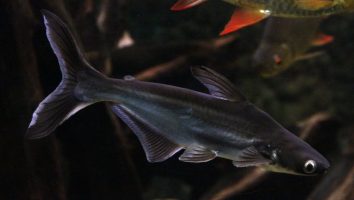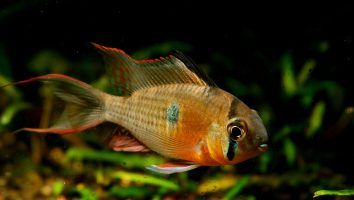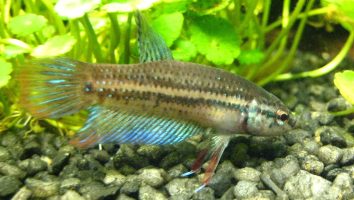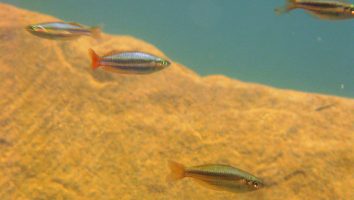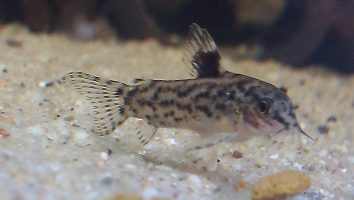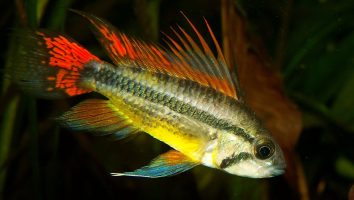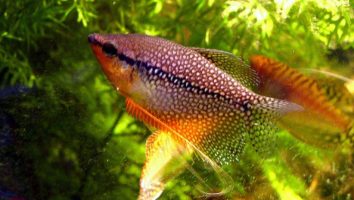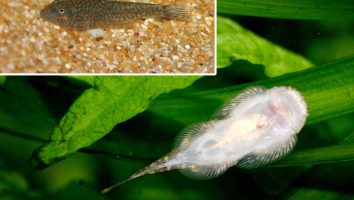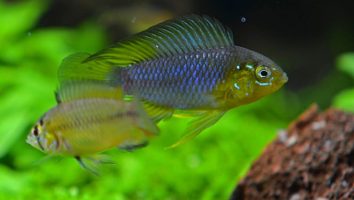The Lake Wanam rainbowfish is a beautiful and peaceful freshwater fish that is perfect for community tanks. They are not demanding in terms of care and are very easy to breed.
This guide will teach you everything you need to know about Lake Wanam rainbowfish care. You’ll learn about their diet, size, lifespan, and more!
Table of contents
Species overview
Lake Wanam rainbowfish (Melanotaenia Wanamensis) is a species of freshwater fish that is endemic to Lake Wanam in Papua New Guinea.
This fish was only discovered in 2006, which makes it a fairly new species. It is a part of the melanotaeniidae family, which contains other well-known rainbowfish such as the Australian rainbowfish.
Lake Wanam rainbowfish grow to be about 2-3 inches long and are characterized by their bright colors and patterns. The males are usually more brightly colored than the females.
These fish are not currently commercially bred, which means they are not widely available. However, they are sometimes available through specialty aquarium stores and online retailers.
If you are interested in keeping this fish, it is important to note that they prefer to live in groups. A minimum tank size of 20 gallons is recommended, and the tank should be well-planted with plenty of hiding spots.
Appearance
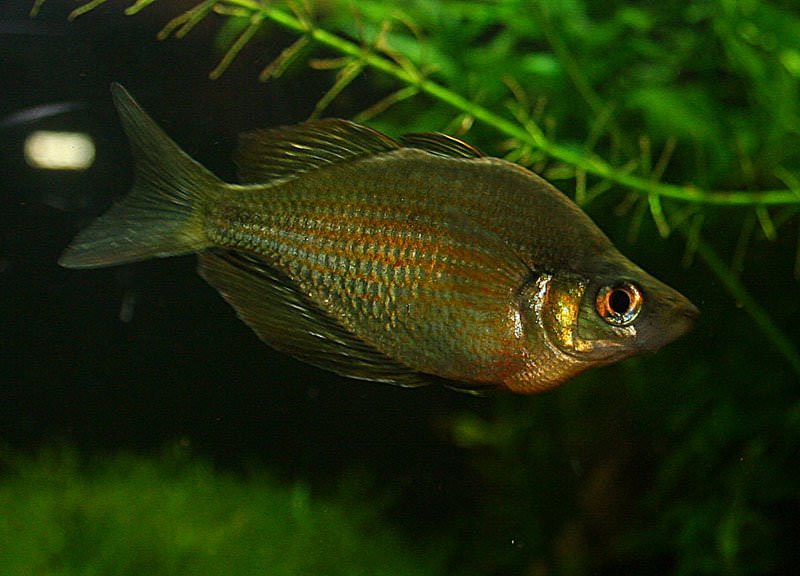
One of the first things you’ll notice about this beautiful freshwater fish is their coloration. The males of this species are a deep blue all over their bodies.
This blue coloration is broken up by a few different things. The first is a series of black stripes that run vertically down their sides.
There are also some orange and red highlights on their fins as well as their tails. Females are not as colorful as the males, but they are still very pretty.
They tend to be a pale blue with some of the same stripes as the males. The fins on females don’t have the same intense coloration, but they do have a bit of orange.
Lake Wanam rainbowfish have a very long and thin body shape. This gives them a lot of speed and agility in the water.
They have a moderate sized dorsal fin that starts about two-thirds of the way back on their body. This fin is tall and slightly curved.
Their anal fins are roughly the same size and shape as their dorsal fins. Lake Wanam rainbowfish also have a forked caudal fin that’s the same height as the thickest part of their body from top to bottom.
Lifespan
Lake Wanam rainbowfish have a lifespan of 2 to 3 years.
As with most fish, their lifespan can be impacted by a number of different factors. Things like water quality, diet, and stress levels all play a role in how long they live.
Generally speaking, these fish are pretty hardy and do well in a variety of different environments. As long as they’re kept in relatively clean water and have a good diet, they should do well.
Size
Lake Wanam rainbowfish are one of the larger species of rainbowfish and can grow to be up to 4 inches in length. However, they are usually closer to 3 inches in length. These fish are also some of the longest-lived rainbowfish with a lifespan of up to 10 years.
Tank
Tank Size
The minimum recommended tank size for a school of Lake Wanam rainbowfish is 50 gallons. If you’re looking to keep a single fish, you can get away with a smaller tank but we still recommend at least 30 gallons.
As with most fish, the more space you can provide the better. These fish are relatively active and will appreciate the extra room to swim.
Water Parameters
The lake Wanam rainbowfish is a peaceful community fish that does well in a variety of different environments.
As long as the water is clean and the parameters are within the ranges below, they should thrive.
- Water Temperature: 72 to 82 degrees Fahrenheit
- pH Levels: 7.0 to 8.0
- Water Hardness: 5 to 19 dGH
- Alkalinity Levels: 3-10 dKH
What To Put In Their Tank
Lake Wanam rainbowfish are a peaceful species that do best in groups. They’re not too picky when it comes to the plants and decorations you put in their tank, but there are a few things to keep in mind.
First and foremost, these fish like to have plenty of places to hide. This can be in the form of plants, caves, or anything else that provides some cover.
We recommend using a substrate that’s on the darker side. This will help bring out the colors of these fish and make them feel a little more comfortable.
As for plants, you can use just about anything. These fish aren’t known to nibble on vegetation, but they might uproot some things when they’re swimming around.
In terms of other decorations, it’s really up to you. These fish aren’t too fussy, so feel free to get creative!
Common Diseases
There are a few diseases that you should be aware of when keeping Lake Wanam rainbowfish. The most common one is ich, which is a parasite that can affect freshwater fish of all kinds.
This disease is characterized by white spots on the body of your fish. If left untreated, it can be deadly.
Other diseases that can affect this species include infections (usually of the skin or fins), parasites, and issues with the eyes.
The best way to prevent these diseases is to maintain clean and stable water conditions in the tank. A well-maintained tank will always lead to healthier fish.
You should also quarantine new fish before adding them to the tank. This will help to ensure that any illnesses they may be carrying don’t spread to the rest of the fish in the tank.
Behavior & Temperament
The Lake Wanam rainbowfish is a peaceful and social creature. It’s known for being a great community fish because it gets along well with others.
Although it’s not a fast swimmer, the Lake Wanam rainbowfish is an active creature. It spends most of its time swimming in the middle of the water column or near the surface.
When it’s not swimming, the Lake Wanam rainbowfish likes to rest on leaves or other objects near the surface of the water.
This fish is also known for being a good jumper, so make sure your aquarium is covered!
The Lake Wanam rainbowfish is a peaceful fish that typically doesn’t bother other tank mates. However, it can be aggressive towards fish that are similar in appearance to itself. So, if you’re keeping more than one Lake Wanam rainbowfish in your tank, make sure they have plenty of space to themselves.
Tank Mates
Tank mates for Lake Wanam rainbowfish are pretty easy to come by. These fish are peaceful and often get along with other species.
The main concern is finding fish that can handle the same water conditions. Lake Wanam rainbowfish come from brackish waters, so they won’t do well in a completely freshwater tank.
You’ll need to find fish that are either tolerant of brackish water or come from brackish habitats themselves.
Some compatible tank mates for Lake Wanam rainbowfish include:
- Bumblebee goby
- Scat
- Mollies
- Knight goby
- Clown goby
- Boeseman’s rainbowfish
- Archerfish
Breeding
The Lake Wanam rainbowfish is a pretty easy fish to breed. They’re not too picky about the water conditions and will readily spawn in most aquariums.
To start, you’ll need to set up a breeding tank. It should be at least 20 gallons and filled with soft, acidic water. The temperature should be around 78 degrees Fahrenheit.
Then, add some live plants to the tank. These fish love to lay their eggs in plants, so the more plants you have the better. Java moss is a good choice.
When ready, add a group of six fish to the tank. Two males and four females is a good ratio.
The female Lake Wanam rainbowfish will lay her eggs in the plants. The male will then fertilize them. After that, the parents will lose interest in the eggs and you can remove them from the tank.
The eggs will hatch in about a week. When they do, you can start feeding the fry baby brine shrimp.
Conclusion
The Lake Wanam Rainbowfish is a beautiful and peaceful fish that is perfect for the community tank. They are easy to care for and get along well with other fish.
The only downside to this fish is that they are not very common, so they can be difficult to find.
Overall, we think the Lake Wanam Rainbowfish is a great choice for the beginning aquarist or the experienced fish keeper looking for a new addition to their tank.

